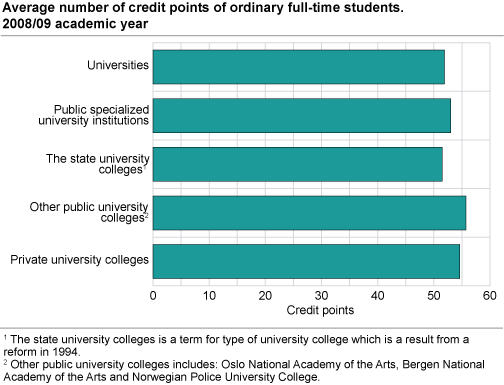Content
Published:
This is an archived release.
Nine in ten complete credit points
Of those registered as ordinary full-time students in the autumn semester 2008, nine out of ten students completed credit points during the 2008/2009 academic year. A full-time workload of 60 credit points was completed by one half of all students.
Sixty credit points correspond to a full-time study, but many complete less than that. About one third of ordinary full-time students produced between 30 and 59 credits, while one out of ten did not complete any credit points. It is not known how many of these people are wrongly registered as being students. Some may remain registered after they have graduated, while others may have paid their student fees but not enrolled in any subjects. For this reason, credit point production is also reported as an average for students who actively completed credit points during the 2008/2009 academic year.
The description “ordinary students” covers students who are not in continuing or distance education. Students in continuing or distance education often have their job as a main occupation. In autumn semester 2008, about 14 000 persons followed a part-time continuing study. Four out of ten in this group completed between 30 and 59 credit points during the academic year 2008/2009.
Ordinary studentsare students who are not in continuing or distance education. |
Full-time studentsStudents' overall course registrations form the basis for calculation. To be counted as a full-time student, the student must be registered for courses that provide at least 70 per cent of 60 credits. There are a few exemptions. This applies to any educational institutions where Statistics Norway receives information that a course is full-time or part-time study. |
Health science fields dominate
The most popular field of study was also the field with the highest share of students who produced 60 credit points in 2008/2009. Of “ordinary students”, six out of ten had a full study progression. Students in the field “Teacher Training and Pedagogy” had the second largest share of students producing 60 credit points. Almost 54 per cent completed a minimum 60 credit points.
Of all 240 500 students registered as students by tertiary study institutions in Norway during the academic year 2008/2009, 203 200 completed credit points, i.e. 85 per cent of students gained credits. Students at specialised university institutions had the highest share of students producing credits with 87 per cent.
Women account for more credit points
More women than men completed a full-time loading of 60 credit points. Among ordinary full-time students, 53 per cent of the female students achieved 60 credits or more, while 49 per cent of male students did the same.
Tables:
- Table 1 Completed credit points in tertiary education, by type of institution, ownership and educational institution. Absolute figures and per cent. 2008/09 academic year
- Table 2 Credit point production of registered tertiary students, by gender and type of institution. Per cent. 2008/09 academic year
- Table 3 Credit point production of registered tertiary students, by gender and field of education. Per cent. 2008/2009 academic year
- Table 4 Average credit point production per student with completed credits in tertiary education, by type of institution, gender and age. Absolute figures. 2008/2009 academic year
- Table 5 Credit point production of tertiary students registered in the autumn semester 2008, by type of education and credits achieved in the 2008/09 academic year. Per cent
- Table 6 Completed credit points of ordinary full-time students in tertiary education, by type of institution, ownership and educational institution. Absolute figures and per cent. 2008/09 academic year
- Table 7 Creditpoint production of ordinary full-time tertiary students, by gender and type of institution. Percent. 2008/2009 academic year
- Table 8 Credit point production of ordinary full-time tertiary students, by gender and field of education. Per cent. 2008/2009 academic year
- Table 9 Average credit point production per ordinary full-time student with completed credits in tertiary education, by type of institution, gender and age. Absolute figures. 2008/2009 academic year
The statistics is published with Credits and graduations from higher education.
Contact
-
Statistics Norway's Information Centre
E-mail: informasjon@ssb.no
tel.: (+47) 21 09 46 42

